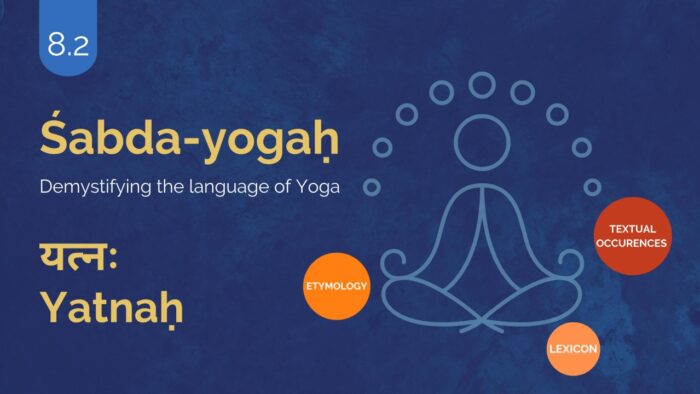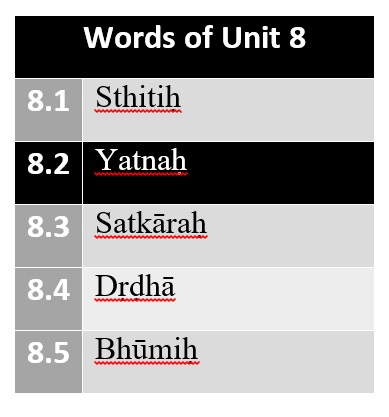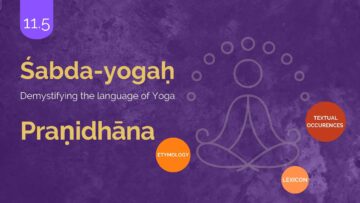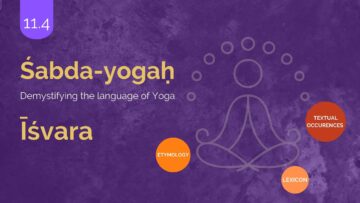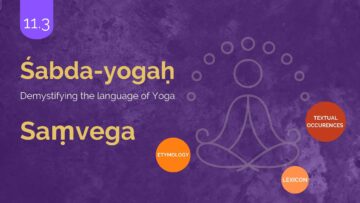Introduction
In this series, Yogic terminologies will be taken up and their –
- Etymological analysis,
- Lexical descriptions and
- Textual occurrences in Yogic literature and their commentaries, as available, will be presented. And finally observations will be made on the references.
Three texts – Yogasūtra, Haṭha-yoga-pradīpikā and Bhagavad-gītā are consulted for textual occurrences portion.
Śabda-yoga is intended to help students, teachers, and professionals of Yoga to develop a sound grammatical, contextual, and thereby an authentic and immersive understanding of Yoga terminologies.
8.2 Yatnaḥ
From the among the five words for this unit 8, this part discusses the second word Yatna.
Etymology
यत + नङ् = यत्नः
yata + naṅ = yatnaḥ
- यतyata is the root that means प्रयत्नPrayatna –to make effort, to try etc
- नङ्naṅ is the suffix. It is added to the root to denote the sense – भाव- Bhāva – the act – it is based on the rule यजयाचयतविच्छप्रच्छरक्षोनङ्yajayācayatavicchapraccharakṣonaṅ (aṣṭādhyāyī 3.3.90)[1]
Based on the etymology the derivative statement then would be यत्यतेइतियत्नःyatyateitiyatnaḥ- the act of making effort.
Lexicon
There is no entry for the word in Amarakośa
Textual Occurrences
Yogasūtra
There are two occurrences to the word Yatna in Yogasūtras, They are as follows –
1) तत्रस्थितौयत्नाऽभ्यासः॥१.१३॥
tatrasthitauyatnā’bhyāsaḥ .. 1.13 .. – The word appears in this Sūtra in the context of defining the term Abhyāsa. Generally, in this Sūtra the word Yatna means effort.The following is the tabulation of the meaning of the word Yanta in this Sūtra from various traditional Saṃskṛta commentaries –
Source: Mahadevan J. Sthiti and Yatna in the abhyāsa of Yoga: A textual study based on 15 Saṃskṛta commentaries of Yogasūtra. Yoga Mimamsa 2021;53:122-8
2) प्रयत्नशैथिल्यानन्तसमापत्तिभ्याम्॥२.४७॥
prayatnaśaithilyānantasamāpattibhyām .. 2.47 .. In this Sūtra the word Prayatna is found. The word Yatna with a prefix pra. This Sūtra gives two techniques that make Āsanasthira and Sukha. The two techniques are prayatnaśaithilya and anantasamāpatti. In the first technique the word Prayatna is to be found. Here again there are varied interpretations to the term Prayatna. A paper on this very Sūtra can be seen here[2].
From the paper it can be observed that Prayatnaśaithilya refers to slackening of effort and it is of three types in the context of practice of Āsanas –
1) Slackening of effort before commencement of practice of Āsanas – not doing strenuous activity before commencing the practice of Āsana.
2) Slackening of effort during the practice of Āsana – which indicates slackening those movements of the limbs which are not essential towards attainment of goal position of Āsana.
3) Slackening of effort after reaching a particular posture – staying still and not moving the body any more.
It is by incorporating these practical insights in the practice of Āsanas that one can reach steady and comfortable posture.
Bhagavadgītā
There is just one reference to the word Yatna in this text. It appears in the sixth chapter.
प्रयत्नाद्यतमानस्तुयोगीसंशुद्धकिल्बिषः।
अनेकजन्मसंसिद्धस्ततोयातिपरांगतिम्॥६.४५॥
prayatnādyatamānastuyogīsaṃśuddhakilbiṣaḥ .
anekajanmasaṃsiddhastatoyātiparāṃgatim .. 6.45 -The states that a Yogin having cleansed himself of impurities of the mind, needs to strive with great effort (Prayatna). And in the course of many births the ultimate state is achieved.
ĀcāryaŚaṅkaraBhagavatpāda comments on the expression prayatna as follows – प्रयत्नात्यतमानः, अधिकंयतमानइत्यर्थः – prayatnātyatamānaḥ, adhikaṃyatamānaityarthaḥ – a yogin who puts in more effort. Adhika – more – is given as the meaning for the word Prayatna.
Haṭhayogapradīpikā
There are nine references to the word in this text. The usages Yatna and Prayatna are alternatively used in this text to indicate the need to put in effort. As there are numerous references, the verse number and a brief description of context of its appearance alone are given here.
- In verse 1.45 – the usage of the expression Prayatna is done to emphasize the effort needed in the practice Padmāsana.
- In verse 2.32 – one finds the expression यत्नतस्त्राटकं गोप्यम् -“yatnatastrāṭakaṃgopyaṃ” – the technique of this beneficial Yoga method Trāṭaka – has to be protected secretly with effort.
- In verse 2.60 –यत्नेन प्राणं घ्राणेन रेचयेत् “yatnenaprāṇaṃghrāṇenarecayet” – this is a discussion on BhastrikāPrāṇāyāma, where one is advised to exhale with Prayatna – effort.
- In verse 3.5 – the expression सर्वप्रयत्नेन प्रबोधयितुमीश्वरम् “sarvaprayatnenaprabodhayitumīśvaram” is found. It is mentioned here that with all efforts mudrās are to be practiced to awaken Kuṇḍalinī.
- In both the verses 3.9, 3.18 – the expression –गोपनीयं प्रयत्नेन “gopanīyaṃprayatnena” is found. In verse 3.9, it is stated that the details about the practice of Mudrās have to be protected secretly. In 3.18 the same is said specifically about Mahamudrā.
- In verse 3.59 – the expression तानं कुर्यात् प्रयत्नतः “tānaṃkuryātprayatnataḥ” – is noticed. Here it is indicated that in the practice of UḍḍiyānaBandha one has to pull back the abdomen both above and below the navel with effort – Prayatnataḥ.
- In verse 3.86 – the expression –यत्नतः शस्तनालेन “yatnataḥśastanālena”is found. This is with regard to the practice of Vajrolī where it is stated that with a clean pipe one has to blow air into the genitals, with effort – prayatnataḥ, to cleanse it.
- In verse 3.90 – the expression – तस्माच्छुक्रं मनश्चैव रक्षणीयं प्रयत्नतः “tasmācchukraṃmanaścaivarakṣaṇīyaṃprayatnataḥ” is found. Here it has been stated that mind and semen (sexual energy) have to be preserved with effort – prayatnataḥ.
Thus it is interesting to note that cutting across all the practices – from Āsana to Mudrās- the need of Yatna/Prayatna is emphasized.
Tabulation of Textual References 8.2
Observations
In general, it is insightful to note that effort (yatna) or more effort (prayatna) is essential towards success in Yoga. The Yoga technique may be very good but the need to strive hard (prayatna) to make the technique is also essential. Specifically –
- In the selfsame text – Yogasūtra, the word Yatna and prayanta have positive and unfavorable connotations. In defining abhyāsa – Yatna has a positive connotation. But in the context of the dual techniques for the practice of āsana– the slackening of Prayanta is advised as – prayatna may hamper sthiratva and sukha in the practice of Āsana.
- The solitary reference in Bhagavadgītā emphasizes the need of prayatna – more effort in the practice of Dhyāna while haṭhayogapradīpikā underlines the need for Prayatna for all the other limbs of Yoga from Āsanas to Mudrās.
- It is also interesting to note that effort is advised in maintaining the secrecy of the teachings. This indicates the need to protect the teachings of yoga from the undeserving and giving it only to the most deserving of the students.
Thus, though the word Yatna is simple word – many interesting and insightful dimensions and inputs emerge when analyzed in a methodical manner through śabdayoga.
Useful Links
Archive of previous Śabdayoga Entries – https://yoga-words-demystified.blogspot.com/2022/01/sabda-yoga-language-of-yoga-demystified.html
Video Explanation of Śabdayoga (Playlist) – https://www.youtube.com/playlist?list=PLHwsf77PLjWvmryW-f0z2hLAHmzaRbKnX
References
- Advaitaśāradā – https://advaitasharada.sringeri.net/
- Amarakoṣasampat – http://amara.aupasana.com/
- Aṣṭādhyāyī – https://ashtadhyayi.com/
- Aksharamukha – https://aksharamukha.appspot.com/
- Avyayakośaḥ, śrīśrīvatsāṅkācāryaḥ, saṃskṛtavidyāsamitiḥ, chennai, 2004
- Gītā Supersite – https://www.Gītāsupersite.iitk.ac.in/
- Nāmaliṅgānuśāsana alias amarakoṣa of amarasiṃha with the commentary vyākhyāsudhā or rāmāśramī by bhānujidīkṣita, Edited with notes by M.M.PanditShivadattaDadimatha, ChaukhambaSaṃskṛtaPrathisthan, Delhi, Reprint 2002
- śabdārthakaustubha, cakravartīśrīnivāsagopālācārya, Vol 4, Bappco Publication, Bengaluru, Reprint 2009
- Yoga-vaiśāradī – https://kymyogavaisharadi.org/
[1]https://ashtadhyayi.com/sutraani/3/3/90
[2]https://www.academia.edu/12132130/Prayatna%C5%9Baithilya_A_technique_in_the_practice_of_%C4%81sana_A_critical_Review_Based_on_the_Comentaries_of_Yogas%C5%ABtra
Unit 8 To be Continued…
Links for previous posts in this unit
Disclaimer: The opinions expressed in this article belong to the author. Indic Today is neither responsible nor liable for the accuracy, completeness, suitability, or validity of any information in the article.

